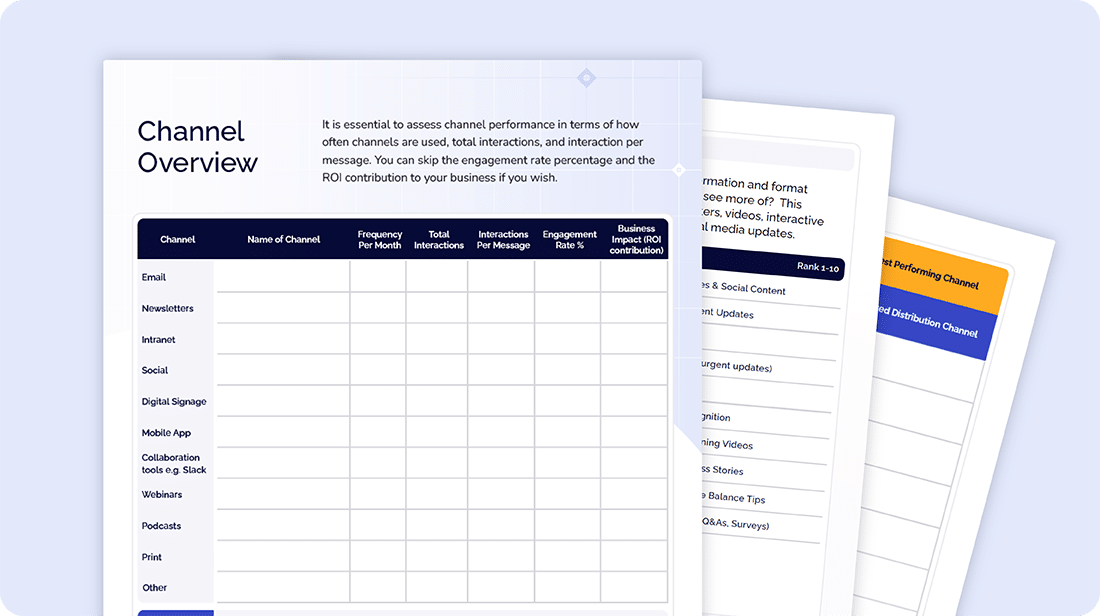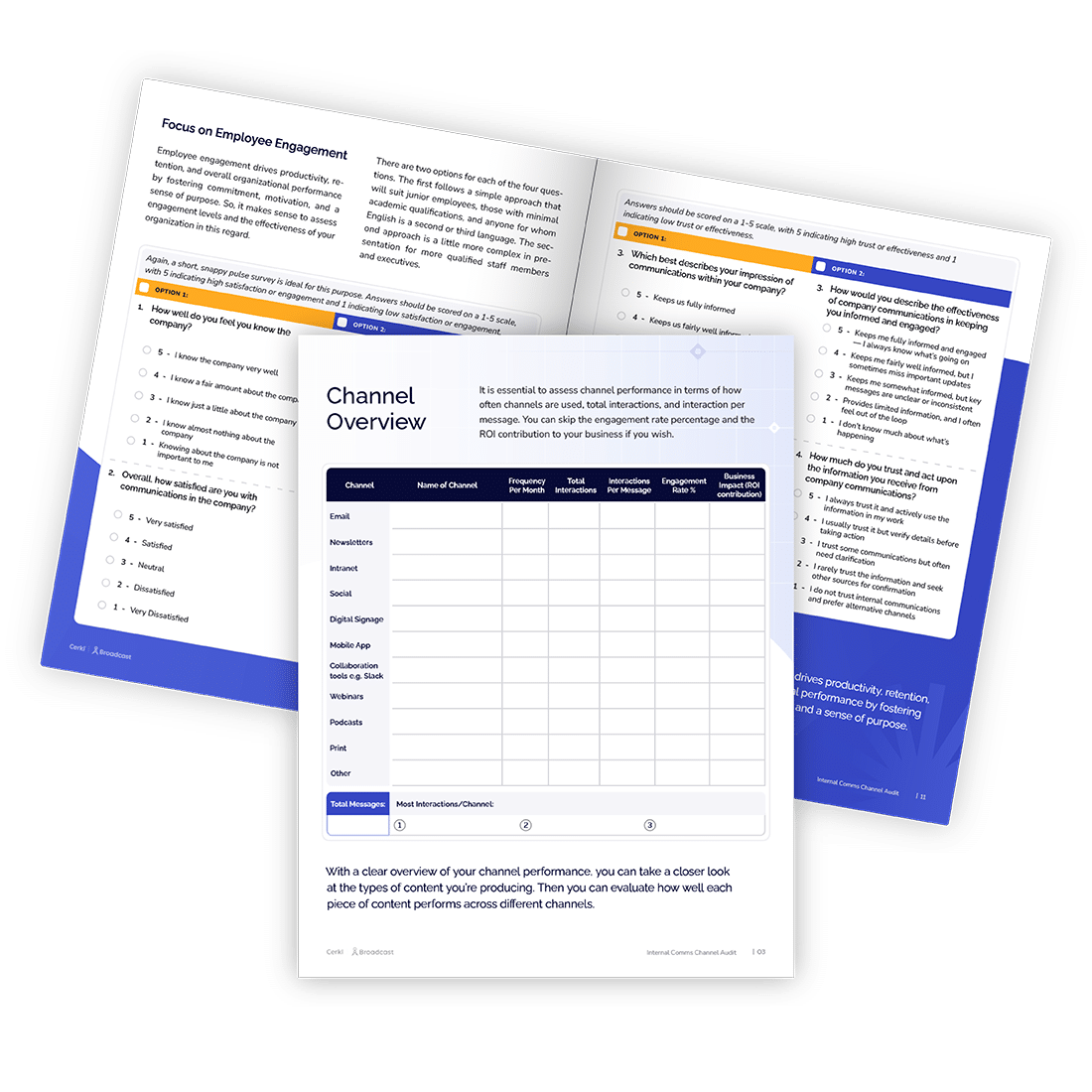Open and click-thru rates are measuring employee communications - not engagement. It’s immeasurable.

.png)
Strategy is an important component of internal communications. Ensure you’re communicating through the right channels at the right frequency with our Internal Communications Channel Audit worksheet.
Access NowTwo weeks ago, in San Francisco, I was sitting on a panel in front of 120+ internal communicators when I made the statement, “Employee engagement is bullshit.”
As you might expect, I was met with more than one “WTF did he just say?!?” facial expression. Don’t get me wrong - while I love catchy National Enquirer-type headlines as much as the next person (is Katie Holmes really wasting away due to a broken heart?) but this was not one of those. I genuinely believe it, and I can explain why.
Once the audience recovered from my “blasphemous” statement, I explained that rather than focusing on engagement, they should focus on quantifying how their employee communications provide value to their company.
I’ll be the first to admit it; I drank the employee engagement Kool-Aid in the beginning. The more I thought about the concept, the more I realized that employee engagement is just another fad buzz-phrase like “Six Sigma Black Belt” or “Business Process Re-Engineering.”
If you Google “what is employee engagement,” there’s no universal definition or standard measurement. In fact, nearly every search result is a vendor trying to sell you something for an undefined problem. Hey, I’m a vendor, so I respect it the game - just not the vague solution.
If you can’t measure something, how do you know the value you’re providing your organization? Internal Comms has painted itself into a proverbial corner by aligning with something that can’t be measured. Houston, we definitely have a problem.
Thinking through all of the touchpoints that IC has within an organization, I’ve discovered four big buckets of value. Before I dive into each, let me clearly state that you can’t show value without measurement.
More on that later, but in the meantime, I’d like to propose the Internal Communications Value Model (ICVM). Yes, I made up an acronym, but hey, everything awesome has one.
Upgrade your company’s internal comms to enhance employee communication

Internal Communications is a supporting role, meaning their teams are understaffed and overworked. By automating tasks like creating an employee newsletter layout and distributing content, your team can focus on more impactful, strategic work focusing on providing bigger value-drivers to the C-suite.
Think about it; you’ve been drowning in tasks. You haven’t had much time to shift to more strategic talk. How can you cut back and save your team time?
What if you didn’t have to produce the employee newsletter any longer? What if you didn’t have to copy/paste the same content to multiple channels? What if you didn’t have to spend hours putting together reports, especially cross-channel?
[Perfect place for a shameless plug.]
Broadcast measures the time our communicators save after they’ve optimized their workflows. On average, our internal comms teams save up to 46 hours a month of tactical work.
No, seriously. Here are some actual numbers from our client:
What could you do with an additional 42 hours per month?
[Ok, come on. I had to.]
How can you get new employees to be productive even faster without overwhelming them? Start by putting on your empathy cap and thinking about how you make employees feel.
Why? There are clearly measurable benefits that your employees’ productivity affects the bottom line of your company. Take your internal comms support for your Sales division, for example. What’s the value to the business if you can get a new salesperson’s productivity to 100% in six months instead of 12? What if you can get them to stay for four years instead of three years?
This is how you can show your higherups your team’s real value: real numbers.
What if on Day 1, every new employee received a welcome message that asks them what they’re interested in? Then they received that type of content in their employee newsletters. Essential housekeeping information automatically sends, so they don’t have to weed through tutorials or intranet to obtain info on where and how to purchase office supplies, sign up for benefits, get access to technology, or direct deposit set up.
Learning and Development can truly partner with Internal Communications for this strategic information to help onboard employees quickly.
Upgrade your company’s internal comms to enhance employee communication

DC data shows that the average worker spends about 2.5 hours per day, or roughly 30% of the workday, searching for information.
How much is this costing your company? How much time do employees spend viewing the same content on different channels or content that’s irrelevant?
It adds up and in a big, big (you know I’m serious) way. Let me give you a sense of the magnitude of the problem and why internal communicators should be spending as much time as possible, thinking about employee productivity.
If you have 20,000 employees with the average employee making $75/hour (all-in, including benefits) and you save them a measly 10 minutes per month, here’s what that would be worth to your company:
10 minutes/month x $75 = $12.50
$12.50 x 20,000 employees x 12 months = $3,000,000
Once again: Real numbers. Real value. Not some B.S. unmeasurable employee engagement.
Think about the collective time it takes employees to weed through email correspondence from customers and colleagues. How much time could employees save by receiving and locating the content they need when they want it?
Now, internal comms professionals can reserve dedicated, all-employee emails for critical updates that are time-sensitive and impact the entire organization while decreasing their email sends.
This is by far the biggest bucket of value that most communicators ignore and/or don’t take credit for. The total cost to replace an average employee in your organization is much higher than you would guess. Ask HR; they should have this number.
Here’s the good news - this tight labor market is forcing all companies to think about how we treat people critically. Meaning there’s a brighter spotlight on the work of internal communicators.
What if you started thinking about how to drive down retention? Maybe you try a video spotlight series on a location with high attrition? Perhaps you want to think through how we onboard a specific class of employees with historically low retention?
The point is that you have the power to drive real change (and value) to your organization. You can’t possibly think strategically if you’re drowning in tactical work. Let’s get away from thinking about this esoteric concept of employee engagement and start thinking more about how internal communications can have a significant impact on your company’s real business objectives.
So, how do the most successful businesses know they are communicating effectively? They audit their communications. Download the internal comms audit they use for free, no risk, no commitment.

Upgrade your company’s internal comms to enhance employee communication
Want feedback? If you complete it, we will provide you with free, personalized advice on how to improve. Get started using your email.

Upgrade your company’s internal comms to enhance employee communication